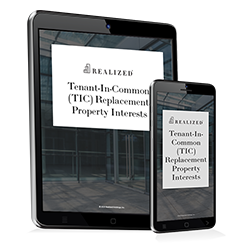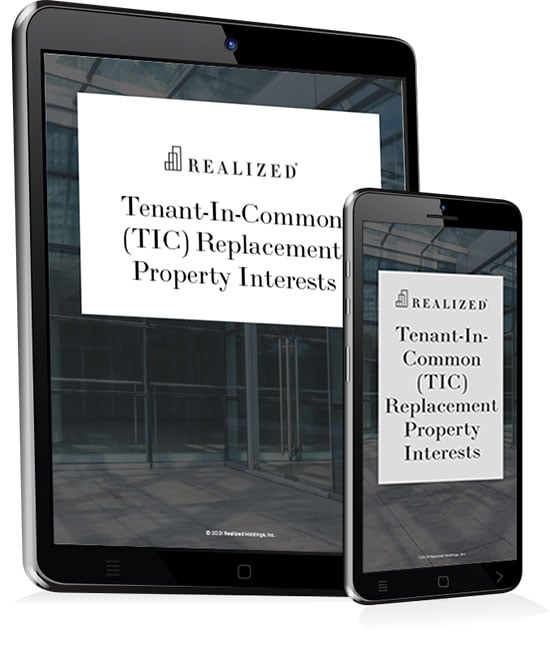
If you’re seeking to grow your investment portfolio while deferring capital gains tax, a 1031 Exchange is a widely used strategy that allows for the reinvestment of proceeds from the sale of investment real estate into like-kind property, provided IRS requirements are met.
One investment structure involved in 1031 Exchanges is the tenancy-in-common (TIC) ownership. In such an arrangement, each investor holds a separate, undivided ownership interest in the property. While ownership percentages may vary, all investors have legal access to the entire property in accordance with their interests, and rights are defined by the TIC agreement. These structures can be complex, so it’s not surprising that many investors wonder how 1031 TIC transactions work.
In this blog post, Realized 1031 has shared an informative guide detailing the TIC 1031 Exchange process, rules to follow, and some considerations to keep in mind. Let’s dive in.
Basics of a 1031 Exchange
A 1031 Exchange is a kind of tax-deferral strategy where you exchange a like-kind property for another. Since no sale occurs, there is no taxable event. The primary benefit of this transaction is to preserve your capital gains so they can continue growing. There are also other advantages you can expect, such as portfolio growth. The ability to swap assets lets you seize opportunities in other promising sectors. However, 1031 Exchanges carry strict timelines, documentation requirements, and the risk of partial tax liability if proceeds are not fully reinvested.
The IRS imposes to prevent abuse. These include the following:
- Real Property: You can only exchange real property. Other types of assets, such as interests in a partnership, cannot be swapped.
- Like-kind Requirement: The relinquished and replacement property must be in the same category of real property. More specifically, the assets must have been held for investment or business use.
- 180-day Timeframe: The entire transaction must happen within 180 days.
Basics of a Tenancy-in-Common
A TIC is a legal arrangement for property ownership where two or more investors jointly own the asset. Each one has varying fractional interests, meaning ownership percentages don’t need to be equal. Ownership percentages can vary, but all co-owners have legal access to the entire property and certain shared rights, subject to the terms of the TIC agreement.
Compared to other similar arrangements (like Delaware Statutory Trusts), TICs offer direct ownership of the property.
Other key characteristics of a TIC include the transferability of interests, which owners can sell or exchange without needing permission from other parties. Plus, there is no automatic survivorship, so interests transfer to the heirs instead of the other TIC owners.
1031 Tenancy in Common: How It Works
Thanks to the guidance provided by IRS, investors have a clearer framework for structuring TIC arrangements that may be eligible for 1031 Exchanges. The procedure outlines criteria under which a TIC interest is more likely to be treated as direct property ownership rather than a partnership interest, which would otherwise disqualify the exchange.
Exchanging Out of a TIC Investment
The process of selling a TIC investment is similar to that of a traditional 1031 Exchange. This time, you’re selling your fractional interest in the property instead of the whole property. Otherwise, the same rules and principles apply, such as working with a qualified intermediary to maintain an arm’s-length transaction.
Exchanging Into a TIC Investment
If you’re entering a TIC property after selling the relinquished asset, the steps you’ll follow have similarities to a traditional 1031 Exchange.
- Within the first 45 days, identify suitable TIC properties (equal or greater value). You may need to work with broker-dealers or 1031 Exchange realtors to find TIC offerings.
- After identifying TICs, make sure to review each one to determine which one best fits your investment criteria. Examine the private placement memorandum or the TIC agreement to gain the full picture of the investment. If a TIC is structured too much like a partnership, where decision-making is highly centralized, the IRS may reclassify the TIC as an ineligible partnership interest for a 1031 exchange
- The final step is to close the exchange after selecting a suitable TIC. Make sure to notify your qualified intermediary about this step so they can transfer the proceeds into the TIC. Plus, ensure that the entire transaction happens within 180 days to maintain your tax deferral status.
Wrapping Up: The Tenants in Common 1031 Exchange Process
A TIC can be a suitable investment structure for those undergoing 1031 Exchanges, allowing you to enjoy benefits like direct ownership, diversification, and tax deferral. Whether you’re selling into or out of a TIC using a 1031 Exchange, make sure to follow the rules set by the IRS to maintain your tax-deferred status. Work with experts like our team at Realized 1031. We can provide guidance and solutions to help you easily navigate this type of transaction, increasing the potential for maximum returns. Contact us to schedule an initial appointment.
The tax and estate planning information offered by the advisor is general in nature. It is provided for informational purposes only and should not be construed as legal or tax advice. Always consult an attorney or tax professional regarding your specific legal or tax situation.
Cited Sources:
https://www.irs.gov/pub/irs-drop/rp-02-22.pd9
https://www.nerdwallet.com/article/taxes/1031-exchange-like-kind



